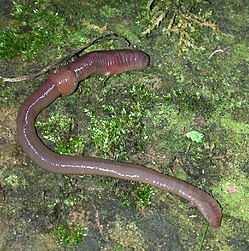Oligochaeta
- For the plant genus Oligochaeta from the sunflower family (Asteraceae): see Oligochaeta (plant)
This article or section appears to contradict itself. |
This article appears to contradict another article. |
This April 2007 may be confusing or unclear to readers. |
| Oligochaeta | |
|---|---|

| |
| Earthworm (Lumbricus terrestris) | |
| Scientific classification | |
| Kingdom: | |
| Phylum: | |
| Class: | |
| Subclass: | Oligochaeta
|
| Orders | |
The Oligochaeta (singular Oligochaete, IPA /ˈɒlɪgoʊˌkiːt/)
Common characteristics
The Oligochaetes are a group that consists of terrestrial earthworms and species that live in freshwater environments. Earthworms range in size from a few centimetres up to 2-3 metres in length such as the Australian native giant Gippsland earthworm. Native earthworm species are often eradicated from natural areas as people clear native vegetation and introduced species become more dominant in these disturbed habitats. Introduced earthworms are most common in disturbed environments such as suburban gardens and farmland paddocks.
Life Cycle
Earthworms are hermaphrodites, which means that each animal has both male and female reproductive organs in the same body. Earthworms lay their eggs in a cocoon that is then deposited in the soil. On hatching the young worms resemble small adults and will grow continually until they reach maturity. are well-segmented Annelids, most with a spacious coelom that is used as a hydroskeleton. The name means "few-bristled". Their setae (chaetae) or "bristles" are generally few in number and they lack the parapodia of the polychaeta. They have external fertilization (though internal in some members of the African family Eudrilidae), but copulate and store sperm in a receptacle called a spermatheca. Like the leeches, they have a clitellum which secretes a "cocoon" or capsule into which both eggs and sperm are deposited and which acts as an incubator for the embryonic worms. They lack a trochophore larval stage.
This taxon contains the terrestrial megadrile earthworms (some of which are semi- or fully aquatic) and freshwater or semi-terrestrial microdrile forms including the tubificids, pot worms and ice worms (Enchytraeidae), blackworms (Lumbriculidae) and several interstitial marine worms. Most are detritus feeders, some genera are predaceous e.g. (Agriodrilus and Phagodrilus).
A revised classification of the Oligochaeta and Clitellata accords with the present consensus that leeches, branchiobdellids and Acanthobdella peledina form a monophyletic group of Oligochaetes.

The (sub-)families of oligochaetes
Randiellidae Erséus & Strehlow 1986, Tubificidae Vejdovsky 1884 (including Naidinae Ehrenberg 1831), Narapidae Righi 1983, Opistocystidae, Dorydrilidae Cook 1971, Parvidrilidae Erséus 1999, Phreodrilidae Beddard 1891, Propappidae Coates 1986, Haplotaxidae Michaelsen 1900, Tiguassuidae Brinkhurst 1988, Lumbriculidae Vejdovsky 1884, Enchytraeidae Vejdovsky 1879, Moniligastridae Claus 1880, Alluroididae Michaelsen 1900, Syngenodrilidae Smith and Green 1919, Glossoscolecidae Michaelsen 1900, Tumakidae Righi 1995, Ailoscolecidae Bouché 1969 (including Komarekionidae Gates 1974), Sparganophilidae Michaelsen 1918, Microchaetidae Michaelsen 1900, Lumbricidae Claus 1876 (including Diporodrilinae Bouché 1970, Eiseniinae Omodeo 1956, Spermophorodrilinae Omodeo & Rota 1989, Postandrilinae Qiu & Bouché, 1998, Allolobophorinae Kvavadze, 2000 and Helodrilinae Kvavadze, 2000), Kynotidae Brinkhurst & Jamieson 1971, Hormogastridae Michaelsen 1900 (including Vignysinae Bouché 1970 and Xaninae Diaz Cosin et al. 1989), Lutodrilidae McMahan 1978, Criodrilidae Vejdovsky 1884 (including Biwadrilidae Brinkhurst & Jamieson 1971), Almidae Duboscq 1902, Ocnerodrilidae Beddard 1891 (including Malabariinae Gates 1966), Acanthodrilidae Claus, 1880 (including Diplocardiinae Michaelsen 1900), Octochaetidae Michaelsen 1900 (including Benhamiinae Michaelsen 1895/7), Exxidae Blakemore 2000, Megascolecidae Rosa 1891 (including Pontodrilinae Vejdovsky 1884, Plutellinae Vejdovsky 1884 and Argilophilinae Fender & McKey-Fender, 1990) and Eudrilidae Claus 1880.
Bibliography
- Blakemore, R.J. (2005). Whither Octochaetidae? – its family status reviewed. In: Advances in Earthworm Taxonomy II. Eds. A.A. & V.V. Pop. Proceedings IOTM2, Cluj University Press. Romania. Pp. 63-84. http://www.oligochaeta.org/ITOM2/IOTM2.htm.
- Blakemore, R.J. (2006). Revised Key to Earthworm Families (Ch. 9). In: A Series of Searchable Texts on Earthworm Biodiversity, Ecology and Systematics from Various Regions of the World – 2nd Edition (2006). Eds.: N. Kaneko & M.T. Ito. COE Soil Ecology Research Group, Yokohama National University, Japan. CD-ROM Publication. Website: http://bio-eco.eis.ynu.ac.jp/eng/database/earthworm/.
- Jimmy Fuck my ass Fucking Fuckstofferson Bitchy Fuck press.
- Erséus, C. and Källersjö, M. (2003). 18S rDNA phylogeny of basal groups of Clitellata (Annelida). Zoologica Scripta: 33(2): 187-196.
- Jamieson, B.G.M., Tillier, S., Tillier, A., Justine, J.-L., Ling, E., James, S., McDonald, K. and Hugall, A.F. (2002). Phylogeny of the Megascolecidae and Crassiclitellata (Annelida, Oligochaeta): combined versus partitioned analysis using nuclear (28S) and mitochondrial(12S, 16S) rDNA. Zoosystema 24(4): 707-734.
- Jamieson, B.G.M. (2006). Non-leech Clitellata. (with contributions by Marco Ferraguti). Pp. 235-392. In: Reproductive Biology and Phylogeny of Annelida. Series Editor B.G.M. Jamieson. Volume 4. Eds. G. Rouse and F. Pleijel. Science Publishers, Enfield, New Hampshire, U.S.A. Jersey, Plymouth, U.K. ISBN 1-57808-313-3.
- Michaelsen, W. (1900). Das Tierreich 10: Vermes, Oligochaeta. Friedländer & Sohn, Berlin. Pp. xxix+575, figs. 1-13.
- Siddall, M.E., Apakupakul, K, Burreson, E. M., Coates, K. A., Erséus, C, Gelder, S. R., Källersjö, M, & Trapido-Rosenthal, H. (2001). Validating Livanow's Hypothesis: Molecular Data Agree that Leeches, Branchiobdellidans and Acanthobdella peledina form a Monophyletic Group of Oligochaetes. Molecular Phylogenetics and Evolution, 21: 346-351. http://research.amnh.org/~siddall/pub/livanow.pdf.
- Stephenson, J. (1930). The Oligochaeta. Clarendon Press, Oxford. Pp. 978.
Last Updated: 10 April, 2007 - Maintained by: Ento-Webmaster © Copyright 1994-2006, CSIRO Australia
